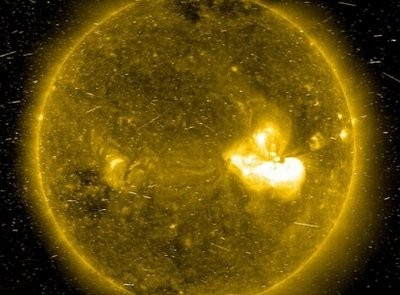Solar flares from the sun are the solar system's version of weather that affects human beings on earth. They are like a tsunami of energy coming from the nearest star to our planet that occasionally make it to earth if the flare strikes the earth's orbit at just the right time.
There is a big one headed toward the earth and it will hit the atmosphere around June 8.
Although solar flares don't disrupt major weather patterns on earth, they can cause spectacular light shows in the night sky.
Geomagnetic Storms

There is a huge solar flare headed toward the planet, the biggest seen in five years according to scientists. Both NASA and the National Weather Service are observing the massive wave of energy headed towards the earth at very fast speeds.
The flare is expected to cause minor to moderate disruptions starting June 8. It won't last more than 24 hours. The flare is happening as the sun is returning to a more active state as it comes out of the solar minimum range.
Flights from Europe to Asia may have to be re-routed just as a precaution. Solar flares can cause increases in solar radiation near the poles, and dozens of planes fly over the North Pole en route to some destinations.
The most severe geomagnetic storms humans have experienced happened in 1989. About six million residents of Quebec, Canada, lost power for nine hours. It was because the magnetic fields intensified ground currents and melted copper wires. The current storm won't be nearly as intense.
Aurora Borealis
The aurora borealis, or the northern lights, are caused when particles of solar ejecta interact with thinner parts of the earth's atmosphere. They are most often observed by humans in northern latitudes of the earth.
Colors of the charged particles can vary widely from deep blues and shades of green to orange and red. As any solid particles enter the earth's upper atmosphere, friction causes them to burn up. Most of our atmosphere doesn't even make these storms visible as it is thick enough to shield humans from the effects of solar radiation.
Yet at the poles, the atmosphere is thinner. Charged particles make it further into the atmosphere and as they interact with air, they change color and oxidize. The dramatic light show can last for minutes or even hours. If you live in Canada and Alaska, get ready for some brilliant colors on the night of June 8.
Satellite Observations
As many as 12 satellites monitor solar activity. You can even view images on the National Weather Service website and NASA. The Solar Dynamics Observatory was launched in February 2010 and is the most advanced space-borne observatory that monitors real-time solar activity.
Dramatic images of the current state of the sun are commonplace now due to modern technology. Flares are rated from 1, or minor, to 5, or severe, based upon their size and intensity when they strike the earth.
























